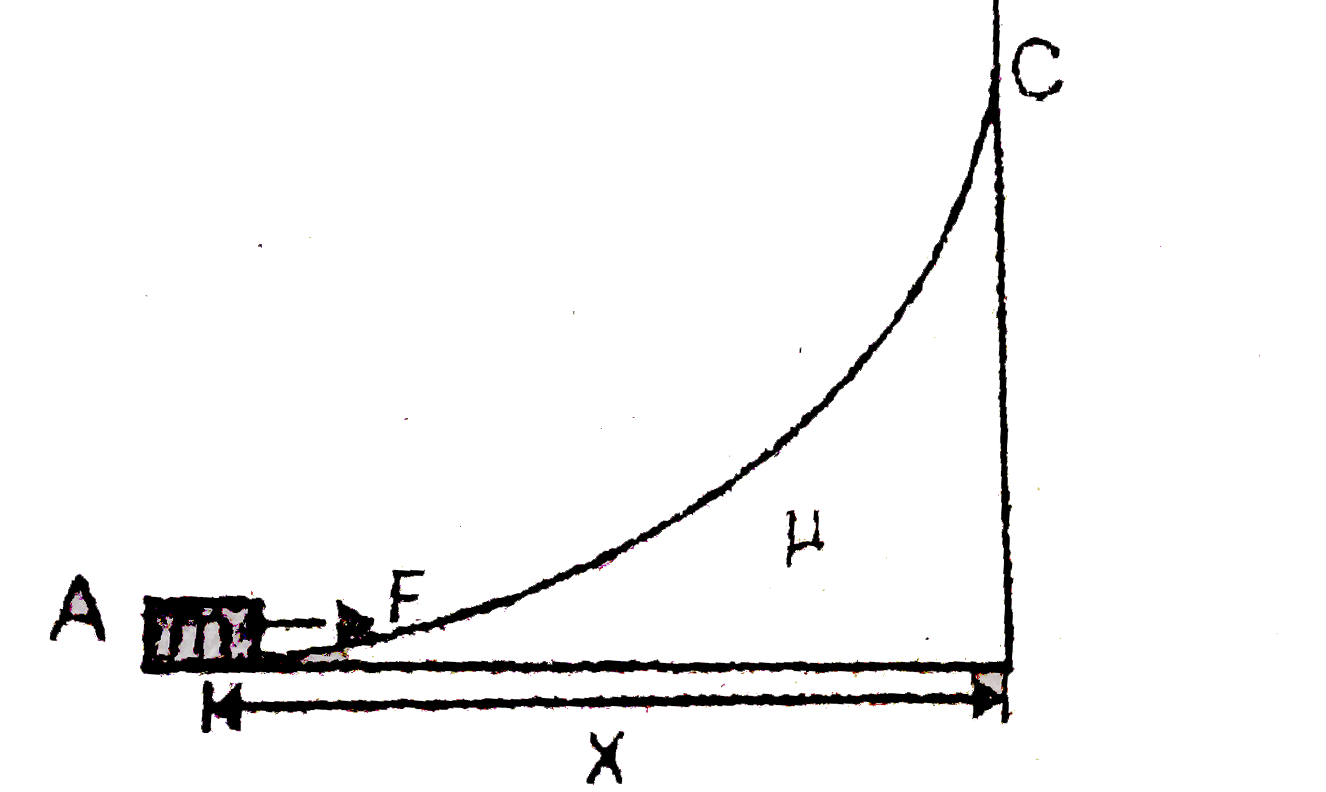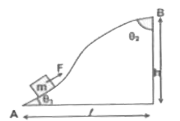Work done by force F to move block of mass 2kg from A to C very slowly is (76λ)J. Force F is always acting tangential to path. Equation of path AB is x2=8y and BC is straight line which tangent on curve AB to Point B (μ between block and path ABC is 0.5). Then value of 'λ' is [g=10m/s2]
![Work done by force F to move block of mass 2 kg from A to C very slowly is (76 lambda) J. Force F is always acting tangential to path. Equation of path AB is x^(2)=8y and BC is straight line which tangent on curve AB to Point B ( mu between block and path ABC is 0.5). Then value of 'lambda' is [g =10m//s^(2)]](https://d10lpgp6xz60nq.cloudfront.net/physics_images/RES_DPP_PHY_XII_E01_344_Q01.png)
Slope of line BC=dydx=2x8=2×48=1
⇒θ=45∘

If the mass m is taken from A to C slowly work done by friction will always be equal to the Wr=μmgx

Now, by Wnet=ΔKE=0
WF−mg(10+2)−μmg(10+4)=0
⇒WF=380=76×5
⇒λ=5
Topper's Solved these Questions
- DAILY PRACTICE PROBLEMBook:RESONANCEChapter:DAILY PRACTICE PROBLEMExercise:DPP No.25
Explore 20 Videos
- DAILY PRACTICE PROBLEMBook:RESONANCEChapter:DAILY PRACTICE PROBLEMExercise:DPP No.26
Explore 9 Videos
- DAILY PRACTICE PROBLEMBook:RESONANCEChapter:DAILY PRACTICE PROBLEMExercise:DPP No.23
Explore 20 Videos
- CURRENT ELECTRICITYBook:RESONANCEChapter:CURRENT ELECTRICITYExercise:High Level Problems (HIP)
Explore 21 Videos
- ELECTRO MAGNETIC WAVESBook:RESONANCEChapter:ELECTRO MAGNETIC WAVESExercise:Exercise 3
Explore 27 Videos
Similar Questions

A block of mass 1 kg is pulled slowly along the curve path ACB by a tangential force as shown in figure. The magnitude of work done by the frictional force when the block moves from A to B is
View SolutionA block A with mass 100kg is resting on another block B of mass 200kg. As shown in figure a horizontal rope tied to a wall hold it. The coefficient of friction between A and B is 0.2 while coefficient of friction between B and the ground is 0.3 . the minimum required force F to start moving B will be.

View Solution
Knowledge Check
A block of mass 10 kg is placed on the rough horizontal surface. A pulling force F is acting on the block which makes an angle θ above the horizontal. If coefficient of friction between block and surface is 43 then minimum value of force required to just move the block is (g=10ms2)
A80 NB160 NC60 ND120 NA block of mass m is slowly carried on a inclined plane by a force F which always acts along the tangent to the plane. If the co-efficient of friction between the block and incline be μ, then work done by force of friction while carrying block from bottom of the plane to the top will be :
 Adependent on the actual shape of the path between point A and B.Bwill have a total positive valueCwill not change if force F is not applied along the tangent to the plane always.Dindependent of the actual shape of the path between points A and B.
Adependent on the actual shape of the path between point A and B.Bwill have a total positive valueCwill not change if force F is not applied along the tangent to the plane always.Dindependent of the actual shape of the path between points A and B.The force acting on the block of mass 1kg is given by F=5−2t. The frictional force acting on the block after time t=2 seconds will be: (μ=0.2)
 A2NB3NC1NDzero
A2NB3NC1NDzero
A block of mass 10 kg is held at rest against a rough vertical wall [μ=0.5] under the action a force F as shown in figure. The minimum value of F required for it is (g=10m/s2)

View SolutionA block of mass 1kg when placed on an inclined plane does not slip down. Now it is taken from A to B and then B to A very slowly such that pulling force is always along the direction of motion of block. If work done by friction in the round trip is 15 J , then find maximum value of h (in m).
View SolutionA block of mass 2 kg, initially at rest on a horizontal floor, is now acted upon by a horizontal force of 10N. The coefficient of friction between the block and the floor is 0.2. If g=10m/s2, then :
View SolutionA block of mass 20 kg is acted upon by a force F=30N at an angle 53∘ with horizontal in downward direction as shown. The coefficient of friction between the block and the forizontal surface is 0.2. The friction force acting on the block by the ground is (g=10ms2)
View SolutionA block of mass 12kg moving on a rough horizontal surface having (μk=0.5,μs=0.6) with a speed 2m/s at any instant and a 12 N force is acting opposite to its motion as shown in figure. Friction force acting on the block is

View Solution

